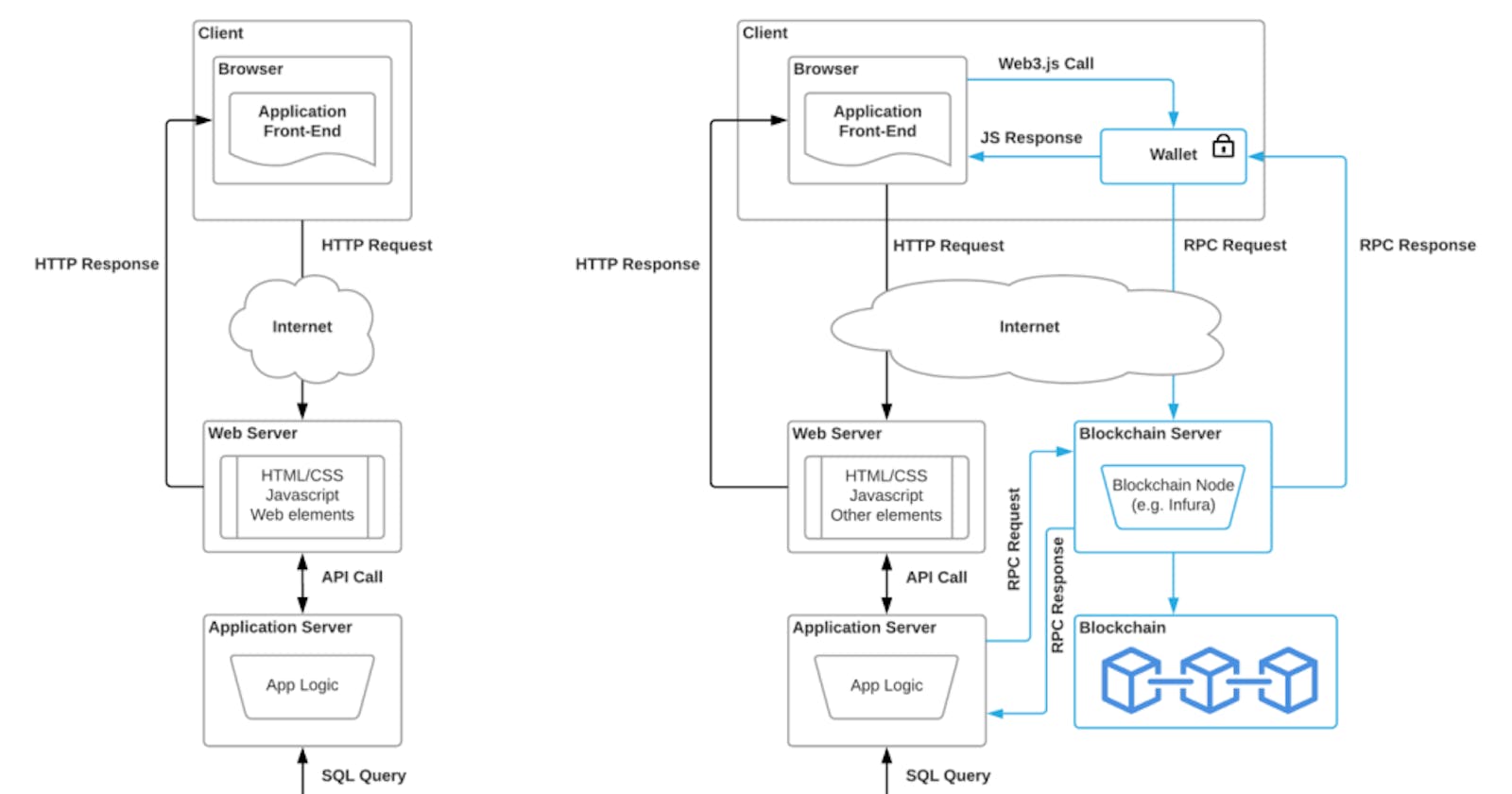In the ever-evolving landscape of digital innovation, the emergence of Web3 architecture stands as a testament to the transformative power of decentralized technologies. While Web2 brought us interconnectedness and user-friendly interfaces, Web3 takes it a step further, introducing decentralization, trustlessness, and resilience to the forefront of digital experiences.
As we delve into the architecture of Web3 applications (DApps), we embark on a journey that redefines the paradigms of how we interact with information, transactions, and each other on the internet. By harnessing the potential of blockchain technology, Web3 architecture reimagines the very foundation upon which digital ecosystems are built.
Let's explore the nuances of Web3 architecture and unravel the distinctions between Web2 and Web3, shedding light on the evolution that is shaping the future of the internet.
Blockchain Applications Architecture
Blockchain applications are built on a decentralized, distributed ledger technology. The architecture typically comprises several key components:
Smart Contracts: These are self-executing contracts with the terms of the agreement directly written into code. Smart contracts run on the blockchain and automate processes.
Nodes: Nodes are participants in the network that maintain a copy of the blockchain. They can be categorized as full nodes (stores the entire blockchain) and light nodes (only stores essential data).
Consensus Mechanism: Different blockchains use various consensus mechanisms (e.g., Proof of Work, Proof of Stake) to validate and agree on the state of the blockchain.
Blockchain Protocol: The blockchain's underlying protocol defines how data is structured, validated, and stored. Ethereum, for example, uses the Ethereum Virtual Machine (EVM).
Decentralized Storage: DApps often use decentralized storage solutions like IPFS (InterPlanetary File System) to store data in a distributed and resilient manner.
Database Layer: For off-chain data storage and management, DApps may use traditional databases or cloud-based solutions.
User Interface (UI) Layer: The UI layer includes the front-end of the DApp, which users interact with. It can be a web application, mobile app, or desktop app.
Web3.js or Similar Libraries: To interact with the blockchain and smart contracts, the DApp's front-end uses libraries like Web3.js. These libraries enable communication with the blockchain and smart contracts via APIs.
APIs and Middleware: Middleware components help bridge the gap between the front-end and blockchain, enabling seamless interactions. These components can include API servers, caching layers, and oracles for external data.
Identity and Access Control: Implement identity management and access control mechanisms to ensure secure and authorized interactions within the DApp.
Security and Auditing: Implement security measures like encryption, authentication, and smart contract audits to protect the DApp from vulnerabilities.
Comparison between Web2 and Web3 Architecture
Web2 Architecture:
Centralized: Web2 applications are centralized, with data and logic hosted on central servers controlled by a single entity.
Client-Server Model: They follow the traditional client-server model, where clients (users) interact with remote servers to access data and services.
Reliance on Intermediaries: Web2 relies on trusted intermediaries (e.g., companies, service providers) to manage data, transactions, and user identities.
Censorship-Prone: These applications can be subject to censorship and data breaches due to centralization.
Web3 Architecture (DApps):
Decentralized: Web3/DApps are decentralized, with data and logic distributed across a blockchain network and peer-to-peer connections.
P2P Model: They follow a peer-to-peer (P2P) model, where users interact directly with the blockchain and with each other.
Trustless and Censorship-Resistant: Web3/DApps are trustless, meaning they operate without intermediaries and are resistant to censorship.
Data on Blockchain: Data is stored on a blockchain and is immutable, providing transparency and security.
Conclusion
In conclusion, the transition from Web2 to Web3 architecture represents a seismic shift in the digital landscape, one that transcends mere technological advancement and delves into the realms of societal transformation. With its decentralized ethos, Web3 architecture fosters a new era of digital sovereignty, empowering individuals and communities to reclaim control over their data, identities, and interactions online.
As we navigate the complexities of this technological evolution, it's imperative to recognize the profound implications of Web3 architecture on our digital future. By embracing decentralization, trustlessness, and resilience, we pave the way for a more equitable, transparent, and secure digital ecosystem.
In the ever-unfolding saga of technological innovation, Web3 architecture stands as a beacon of possibility, inviting us to reimagine the internet not as a centralized hub, but as a decentralized network of limitless potential. As we embark on this journey of exploration and discovery, let us embrace the promise of Web3 and chart a course towards a more decentralized and inclusive digital future.
